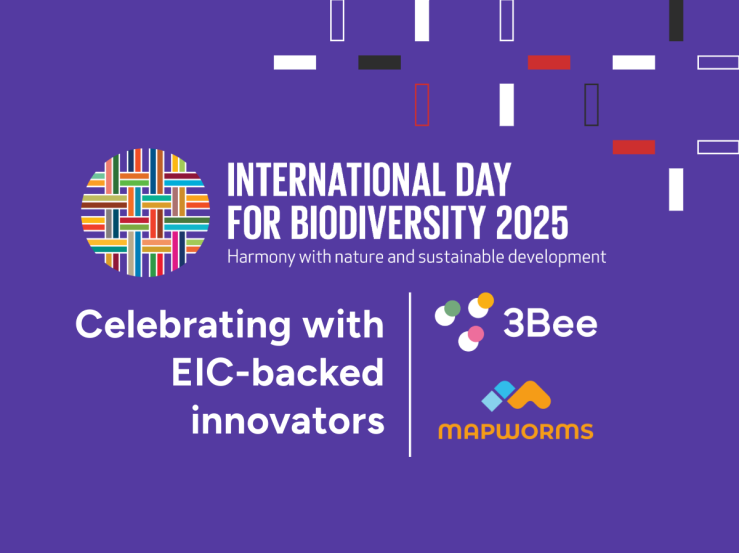Under this year’s theme, ‘Harmony with nature and sustainable development’, the 2025 International Day for Biological Diversity – celebrated annually on 22 May – is a call for the global community to re-examine our relationship with the natural world in light of fast-paced technological advancements. In fact, technology can help to preserve and, even, enhance a healthy balance between human activity and the natural world, as is demonstrated by EIC-backed projects Biodiversity Credits (implemented by EIC Accelerator beneficiary, 3Bee) and MAPWORMS (led by EIC Pathfinder beneficiary, Sant’Anna School of Advanced Studies).
3Bee (Italy): Technology and community efforts as two parallel paths in biodiversity protection
Well aware of the crucial role bees play in safeguarding biodiversity, within the EIC-funded Biodiversity Credits project, the Milan-based company 3Bee is using sensor technology along with beehives to assess, regenerate, study, and protect vulnerable ecosystems and biodiversity.
Leveraging on their advanced IoT system for beehives and satellite data collected in collaboration with the European Space Agency (ESA), 3Bee is dedicated to analysing crucial environmental data to help companies, municipalities and nature parks monitor and manage risks on nature, biodiversity and climate.
This is not all, however: by working with beekepers, farmers, schools and local communities, a large focus is that placed on encouraging people's direct involvement on creating a positive environmental and social impact through land regeneration projects such as the Biodiversity Oases – regenerated natural areas – and dedicated environmental education initiatives.
3Bee’s recent launch of XNatura: the Nature Intelligence division dedicated to environmental monitoring
The significant support of 3Bee to companies, organisations and municipalities in defining a 360-degree biodiversity strategy has already paid off, with more than 100 regenerated oases and 2 billion pollinators protected overall.
Additionally, thanks to the experience acquired in recent years, the Milan-based company announced in March 2025 the launch of XNatura, a division highly specialised in the analysis of nature, biodiversity and climate, combining artificial intelligence, big data, satellite remote sensing and IoT sensors.
As Niccolò Calandri, CEO of 3Bee, recently revealed regarding the launch of the in-house division, the step represents a strategic split of two different, but complementary paths undertaken by the company:
3Bee will continue to strengthen the resilience of the territory by promoting environmental regeneration projects, such as the Biodiversity Oases, and awareness-raising initiatives aimed at citizens, schools, companies and municipalities [...]. At the same time, XNatura will follow a parallel path, in line with its technological and innovative nature.
MAPWORMS (Italy): Pioneering a new concept of bioinspired robots
Traditionally, robots are machines controlled by a central unit and used to perform specific tasks automatically, often in a structured environment.
Inherent in the EIC MAPWORMS project is a challenge of this traditional idea: develop a new concept of bioinspired robots capable of fulfilling tasks in response to environmental stimuli, thanks to smart materials.
The MAPWORMS’ team, led by the Sant’Anna School of Advanced Studies (Italy) and composed of a unique combination of young researchers, research-intensive SMEs and key players in the involved research fields, drew its inspiration for the project from the marine Annelida, marine worms that adapt to their environment with shape changes.
Indeed, the study of the adaptation and plasticity of marine worms will be the first building block of the bioinspired robots capable of sensing environmental cues and adapting to the environment.
Opening up new possibilities in medical and bioinspired robotics
Building on an innovative approach to robotics in which biology is the inspiration, the MAPWORMS team has already made significant strides in developing smart materials, such as DNA-based hydrogels, which enable robots to change shape and stiffness in response to external cues.
These advancements have been showcased at several international conferences as the 16th Hamlyn Symposium on Medical Robotics in London in 2024, where the team highlighted how, by mimicking the plasticity and adaptation of the marine worms, they aim to achieve innovative mechanisms in soft robots which could pioneer new solutions in the field of medical robotics with bio-inspired designs.
Additional Information about 3Bee
3Bee is dedicated to monitoring and protecting biodiversity and pollinators through technology. Supported by the EIC Accelerator, 3Bee coordinates the Biodiversity Credits project, which will employ IoT sensors integrated into honey beehives to monitor colony health and wildlife, including avifauna, insects, and pollinators.
Learn more about 3Bee by visiting the Horizon Europe database and the company official website.
Additional Information about MAPWORMS
MAPWORMS, coordinated by the Sant’Anna School of Advanced Studies, was born with the ambition to overcome the limitations of the current state of art in robotics by proposing a novel bioinspired shape-morphing robot based on smart materials. Supported by the EIC Pathfinder, MAPWORMS is pioneering a new branch of robotics through the development of smart soft materials with shape-morphing and self-healing capabilities, based on DNA components.
Learn more about MAPWORMS by visiting the Horizon Europe database and the official project website.

DISCLAIMER: This information is provided in the interest of knowledge sharing and should not be interpreted as the official view of the European Commission, or any other organisation.

